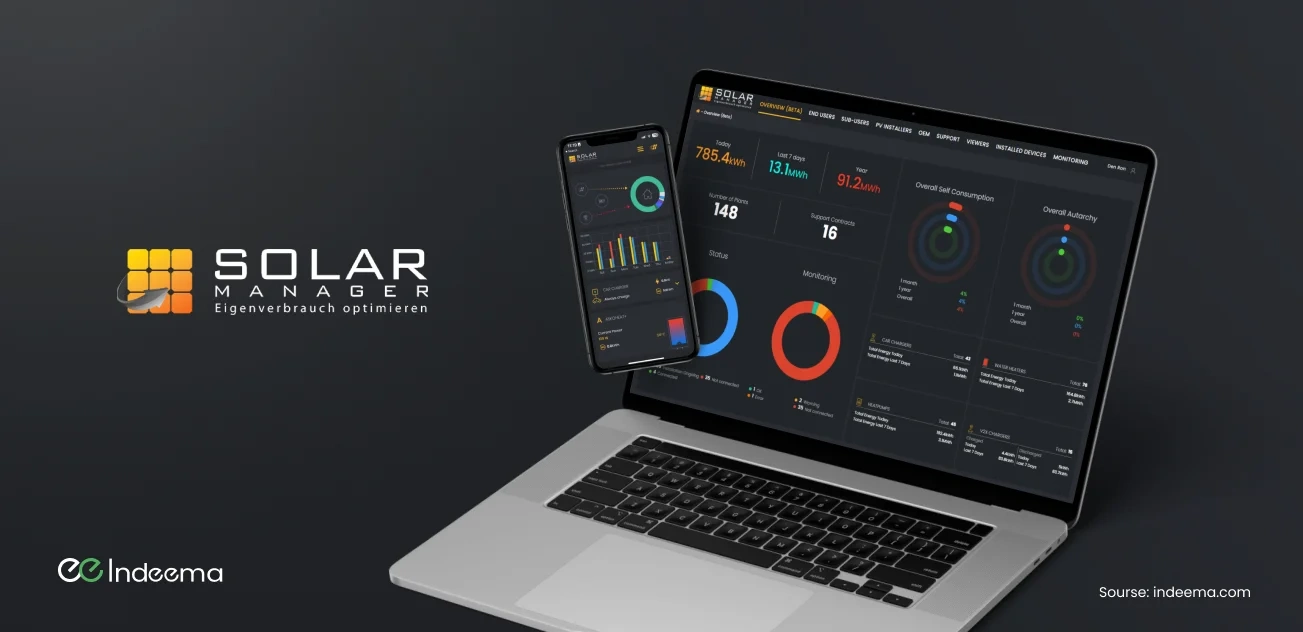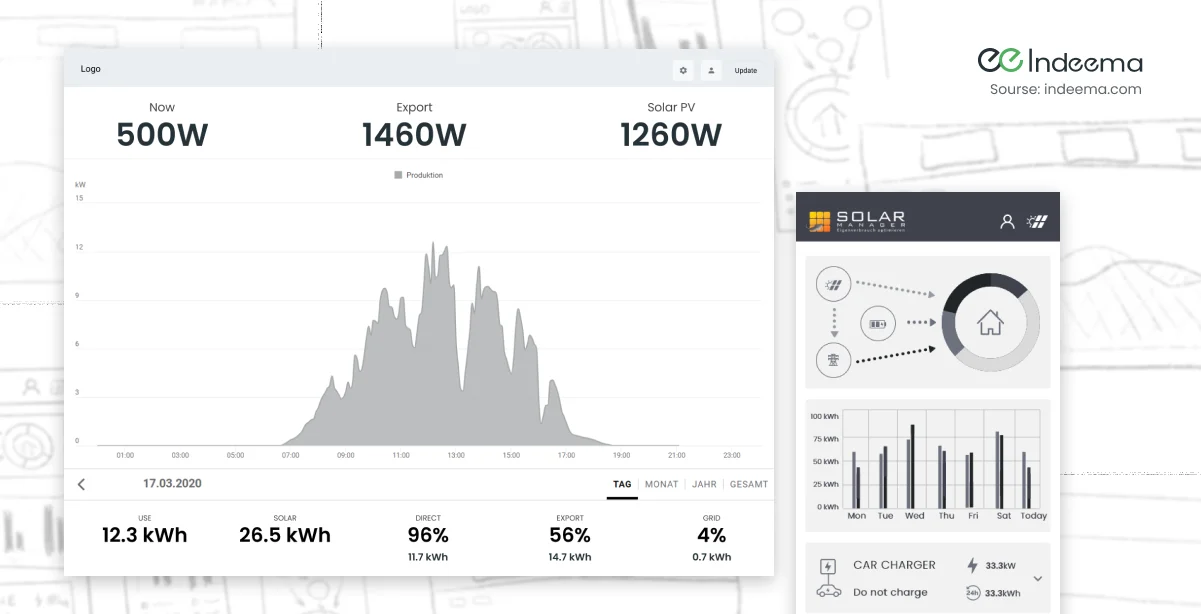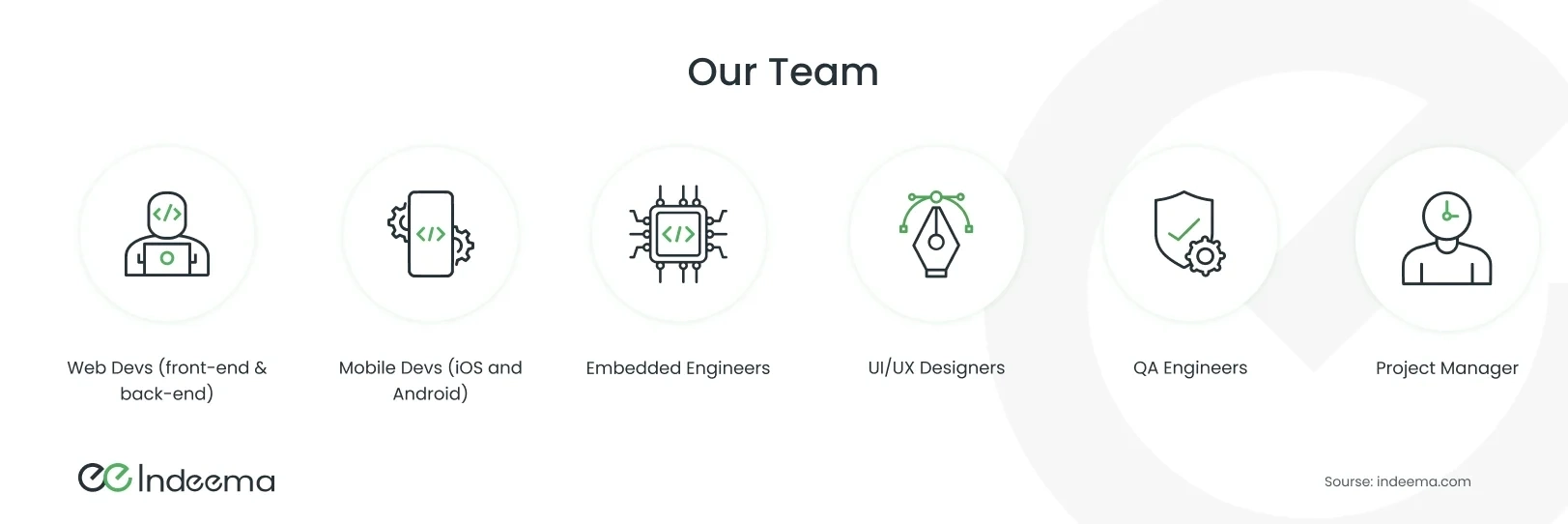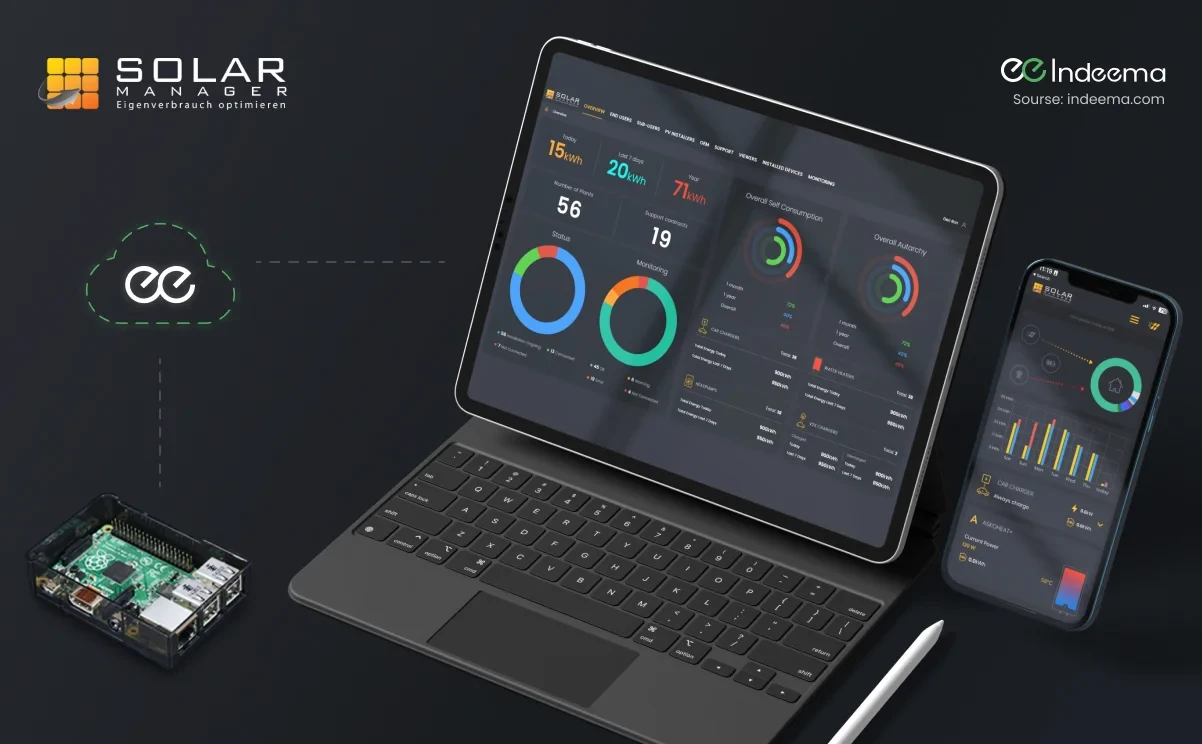Introduction
Smart Energy Consumption with IoT Solar Systems is a web-based IoT solution designed to optimize the consumption and production of solar energy. It provides users with an effective way to manage their solar energy and ensure it's used efficiently.
1. Business Context
Smart Energy Consumption with IoT Solar Systems was developed by a team of 15 engineers with expertise in R&D services, web and mobile development, IoT development, UI/UX design, cloud services, and DevOps.
The solution was created to meet the growing demand for sustainable and clean energy sources for European markets. Its goal was to provide users with a simple and effective way to manage solar energy and harness its full potential.
IoT in solar energy allows users to monitor their solar energy consumption and production in real-time, making it easier to identify avenues for optimization. The solution utilizes cutting-edge technology to provide good mobile connectivity, crucial IoT features, and efficient over-the-air device firmware upgrading capabilities. It also offers PC connectivity via USB for configuration, making it easy for users to manage and customize their solar energy system to their needs.
This way, users can take control of their energy consumption and production, reduce their carbon footprint, and positively impact the environment. IoT and solar energy help users harness the full potential of solar power and make significant progress toward a more sustainable future.
All in all, the solution provides a reliable system for monitoring the precise location and operation of the solar system. Let's take a closer look at one of Indeema's IoT case studies in the energy sector.
2. The Customer's Aspiration: A System for Seamless Solar Management
The product was established to optimize the self-consumption of own produced power through the photovoltaic (PV) production system in single-family homes and small apartment buildings. The customer requested the creation of a system that would allow for installing and controlling solar infrastructure and monitoring energy production and consumption.

The IoT solution comprises two parts: the Device installed in the house, and the Cloud, which also includes an IoT Platform to manage the devices. Depending on the appliances available in a household, a different home configuration may be required to correctly interface the Device with these appliances. This configuration is defined in the Cloud and then retrieved by the Device.
The energy IoT solution was designed to cater to a wide range of households, with thousands of new users each year. Each user or homeowner has a personal login to the Cloud, where they can access their production and consumption data. The Cloud also has Admin access, allowing for an overview of data from all users. Additionally, dedicated access for PV installation companies is possible, allowing these companies to see data on the systems they have installed.
Overall, the goal of the solution is to provide a comprehensive solution for the installation, control, and optimization of solar energy production and consumption in households.
3. The Spark of an Idea: An IoT Platform for Monitoring Energy in the Home
When the client first approached us, they were looking for solar software companies because they had a clear vision of their goal. With a list of requirements in hand, they presented us with their idea to create a platform that would allow homeowners to monitor their electricity consumption and production in real time, all from the convenience of a single tablet that could be mounted on their wall.
This innovative concept aimed to make monitoring energy usage and production more accessible and user-friendly. With the client's passion for their vision and our expertise in software development, we set out to bring this solar technology to life.
4. Delivered Solution
4.1 Getting Started: The R&D Phase
The outcome was a series of wireframes that depicted the platform's flow and user interface. Our developers and designers worked hand-in-hand to bring the concept to life and create a prototype demonstrating the platform's key features and functionalities.
4.2 The Foundation of Success: The Requirements Phase
Once the wireframes and prototype were approved, we started working on the platform's back-end and front-end development. Our team of developers worked to create the system's infrastructure, integrating all the necessary components, including data storage, user management, and security.
We ensured that the platform was highly scalable and could handle an increasing number of users and devices. The end solution was a platform that was easy to use, even for those unfamiliar with the technology behind it.

4.3 Visualizing the Future: Prototyping & Wireframes
Before deploying the platform, we conducted comprehensive testing to identify and fix any bugs or issues. We tested the platform's functionality and performance and ensured that it met the requirements set out in the project's user stories and acceptance criteria.
We finally deployed the platform, and it was a huge success. The customer was happy with the results, and so were the end-users. They found it user-friendly and highly functional as it helped users to monitor and manage their electricity consumption and production more effectively.
4.4 Specification Phase
This phase focused on project planning and defining the priorities for the MVP (Minimum Viable Product) phase and future development. The team worked closely with the client to understand the requirements and ensured that the solution met their needs.
They also defined the key features, functionalities, and technical specifications that would make the Solar Manager a comprehensive solution for monitoring and managing the consumption and production of electricity in households. By the end of this phase, the team had a clear understanding of the project's scope and direction, ensuring that the solution would deliver the desired outcomes.
5. Our Development Process
5.1 UX/UI Design: Creating a User-Centered Design
The design process of the project was a collaborative effort between our team and the client. Our designers were mindful of the client's wishes and worked to create a user-friendly and adaptable design. Wireframes were developed first, followed by design for the web platform, tablet, and ten more apps for OEM roles. Extensive research was conducted to create an optimized design that caters to user experience, and every step was confirmed with the client and aligned with the client's corporate style.
5.2 WEB Development: Building a Comprehensive Monitoring Platform
The project required a complex solar energy management software designed to monitor electricity production and consumption, offer forecast services using artificial intelligence, error monitoring services, data collection about users, and the ability to save their history from the beginning of use.
It has a system of interconnected roles, including end-users, sub-users (apartment buildings), viewers, employees, installers, and OEMs, ensuring that all parties have access to the information they need. This robust system enables efficient and effective monitoring and management of electricity production and consumption.
5.3 Unleashing Mobility: Our Mobile Development Efforts
In addition to the app, ten mobile applications were developed by our team specifically for OEMs. The IoT app allows users to view electricity distribution from solar panels between the main network, battery, and various devices' consumption.
The forecasting service is also available for users to prioritize using solar energy for devices at their homes. Additionally, users can view daily and yearly consumer statistics and manage device connections and disconnections using widgets within the app.
The team also successfully implemented a payment system based on a local provider, which was previously unknown for development in other countries.
5.4 Seamless Integration: Our DevOps & Cloud Development Approach
Our DevOps and Cloud Development team worked to ensure that the IoT platform was scalable, secure, and reliable. They implemented a cloud-based infrastructure and automated deployment processes to allow for efficient and seamless updates.
In addition, they implemented monitoring and logging solutions to proactively detect and address any issues that may arise, ensuring the platform's smooth operation. This was critical in ensuring the success and longevity of the project. The team also worked closely with the client to ensure that the platform met all necessary security and compliance requirements.
6. Involved Talents & Overcoming Challenges
6.1 The Team Involved in the Project
A talented and diverse team was crucial for the success of this project, including:
- ▪️ 5 Web Developers (front-end and back-end)
- ▪️ Mobile Developers for both iOS and Android platforms
- ▪️ Embedded Engineers
- ▪️ UX/UI Designers
- ▪️ QA Engineers
- ▪️ Project Manager

Overall, team's expertise in web and mobile development, embedded engineering, UX/UI design, QA, and project management ensured that the project was completed on time and to a high standard.
6.2 Overcoming Challenges
Our team faced some challenges while delivering the project, but our expertise and problem-solving skills allowed us to overcome them and deliver the best possible solution to our client.
Detailed Graphs: It was necessary to create highly detailed graphs that would display data for various time intervals (an hour, a week, and so on). Our solution was to set up all sensors to collect data every minute, which we then compiled on the back end.
Data Display Optimization: The challenge was to optimize the speed of data display due to the large amount of data that needed to be correctly processed and displayed on the front end. Our solution was to reduce the granularity and frequency of data collection by using TSDB, adding cache layers, and downsampling the inbound stream. We also archived old and less frequently used data to reduce disk usage and cost per user per year.
Accurate Energy Consumption: We encountered issues with the complex calculation of energy consumption, as the estimates did not match. Our solution was to conduct a thorough analysis and correct the formulas to calculate consumed resources accurately and correctly.
7. Boosting Business with Smart Energy Monitoring
7.1 Before & After Cooperation with Indeema
The client had an idea and a desire to create a solution for tracking solar energy usage. With Indeema's expertise in developing cutting-edge IoT solutions, the client's vision became a reality. The result was a Solar Energy IoT System, which interacts with RPI devices and leverages cloud technologies.

The solution has had a significant impact on the client's business. The number of users has increased by 650 times in just two years, and the product has already garnered dozens of distributors and partners. The product is now available at several photovoltaic wholesalers in Europe, a further testament to its growing popularity. The product's continued evolution and expansion will bring even more success to the client's business.
Conclusion
In conclusion, the collaboration between the client and Indeema has brought innovation to reality. The Solar Energy IoT System is a testament to the impact of IoT solutions on businesses. The exponential growth in the number of users and distribution partners is a clear indication of the effectiveness of the solution. As the product continues to evolve and expand, we anticipate even more success for the client's business.
At Indeema, we are committed to providing cutting-edge solutions that meet the industry's growing demands. Our experienced developers and advanced technologies are available to bring your renewable energy projects to life. Choose Indeema for your next IoT project, and let us help turn your ideas into a reality. Contact us today to learn more about our services and how we can help you achieve your goals.
![Smart Energy Consumption & Management with IoT Solar Systems [Case Study] Smart Energy Consumption & Management with IoT Solar Systems [Case Study]](https://indeema-web-images-prod.s3.eu-central-1.amazonaws.com/img/blog/BLOGmax(3)_1683556775217.webp)

